Editor’s Note: This text course is an edited transcript of a live webinar. Download supplemental course materials.
I am here today to talk about the Ponto Plus family of products. Our agenda will cover a brief introduction to our company and review of some candidacy guidelines for bone anchored devices, followed by a discussion of some of the key features of our Ponto Plus processors. After that, we will talk about the Ponto Streamer and wireless connectivity, and then finish with information about the Ponto implant system and an outline of the tissue preservation surgery technique.
History
In 2004, Patrick Westerkull began a bone anchored project with Otorix, which was eventually acquired by William Demant Holding in 2006. This project became the basis for Oticon Medical, which is a sister company of Oticon with headquarters in Copenhagen, as well as our own headquarters in Gothenburg, Sweden. Our first implant system and the accompanying sound processor, Ponto, was launched in 2009. That same year, it got a CE marking, as well as Food and Drug Administration (FDA) approval. In 2011, our second-generation sound processor family included Ponto Pro Power, which was the first-ever digital power sound processor. 2012 saw the launch of our wide Ponto implant, as well as the first implant and abutment system that was designed for tissue preservation surgery, for which we now have FDA clearance.
Last spring, Oticon Medical acquired Neurelec, which is a French cochlear implant manufacturer (the Neurelec device is not commercially available in the United States). It is not a name with which you are likely familiar within the states, as they are mainly focused on European markets, but as our company grows in the future, you will be hearing more from us in the field of cochlear implantation as well. Today, we are in more than 23 countries worldwide and growing.
Twenty-five percent of all bone anchored sound processors sold are Ponto sound processors. Oticon Medical stands on a solid platform for the launch of Ponto Plus for several reasons. First of all, clinical data is showing that users who get the chance to compare alternatives prefer the Ponto sound processor. Our website is in the process of an update, and when it is relaunched, it will include this information in a clinical study section.
Secondly, with a number of years in the field, we know that the features of our products are well proven, both for the existing features and also the synergies that we are getting from implementing the new technologies of Oticon. Thirdly, we know that our products have a recognized and well-functioning design in regard to their usability, but also in how they look and feel for patients. Last, but not least, we have a great software, Genie Medical. Professionals are used to handling this type of programming software, and it is straightforward and easy to use.
Review
I know some of you are familiar with our system, but it is possible that others may be relatively new to bone anchored instruments. There are several candidacy groups for this type of solution. The first indication for candidacy of the Ponto system is conductive or mixed hearing losses. The audiograms of this type (Figure 1) are frequently associated with chronic otitis media and congenital malformations like atresia and microtia. For those patients, it is especially important to note that if the air-bone gap is greater than 30 dB, research indicates that a patient’s speech recognition will likely be better using a bone anchored solution than a conventional air conduction hearing aid. Also, Ponto sound processors in this role can accommodate conductive and mixed hearing losses with an average bone conduction threshold of up to 55 dB.
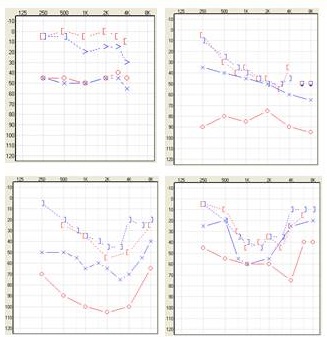
Figure 1. Conductive and mixed audiometric results of candidates for bone anchored hearing systems.
The next indication is for patients with unilateral, profound sensorineural hearing loss, or single-sided deafness (SSD), which is the term we will use. SSD commonly occurs because of acquired causes like acoustic neuroma or sudden deafness, but it can certainly also be congenital. The criteria for fitting an SSD patient is that the thresholds in the good ear are near normal, meaning that the average air conduction threshold should be 20 dB or better.
There is another small group of potential Ponto system users that you might forget about sometimes. Those are the individuals with a medical background that keeps them from being able to use conventional hearing aids. For example, perhaps you have a patient who has severe skin allergies to plastics in or around their ear canal. Though looking at the audiogram in Figure 2 does not make you think of a bone anchored system right away, it is possible that they could get benefit from such a system.
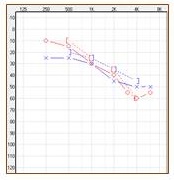
Figure 2. Audiogram of a patient with skin allergies in the ear canal who could not use traditional air conduction hearing aids.
We are launching a full family of sound processors with Ponto Plus to serve patients with varying degrees of hearing loss. The Ponto Plus family has also been built on the Inium platform, and, thanks to our connection with Oticon, we can introduce this modern hearing aid sound processing platform to bone anchored users. Most impressively, this system is the first to introduce wireless connectivity as well.
The fitting ranges remain the same as with the previous sound processor families (Figure 3). Pure conductive losses and mixed hearing losses that have average bone conduction thresholds up to 45 dB can be fit with Ponto Plus, and mixed hearing losses with average bone conduction threshold up to 55 dB can be fit with Ponto Plus Power. Single-sided deafness cases with completely normal hearing in the good ear can be filled with Ponto Plus. If you have an SSD case with a slight high-frequency hearing loss in the good ear, you could consider Ponto Plus Power.
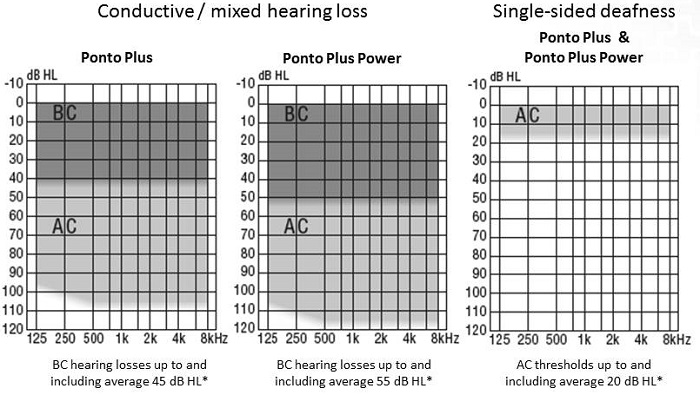
Figure 3. Fitting ranges required for Ponto Plus and Ponto Plus Power.
Patient Needs
As we move forward, we need to always remember that patient needs are our starting point. Our aim as a company is to help improve outcomes for users of our bone anchored hearing systems. We do this from a holistic perspective. In this way, we cover all different aspects that are important for users and their quality of life. The greatest potential for overcoming challenges for users is found outside of the clinical environment and out in their lives. This is where sophisticated sound processing comes into play. Our starting point is always looking the end-user in the typical challenges that they experience and how our products can help remove those challenges.
We asked some patients about this prior to launching our Ponto Plus development. As you can see in the graph in Figure 4, patients prioritized challenges that felt impacted their user experience. The greatest concern was understanding speech in difficult listening situations. I know you will hear that from every patient that you ever see clinically. We wanted to improve that performance and develop a solution that opens up more possibilities for our patients to communicate.
Another priority was feedback. We already felt like we had a great feedback system, but we recognize that we want to improve what we already have. The third topic is a combination of two issues: unclear sounds and distortion of sounds. We wanted to focus on producing a stronger device so that patients would not be bothered by unclear sound or distortion of sounds. They can enjoy the full dynamics of sound.
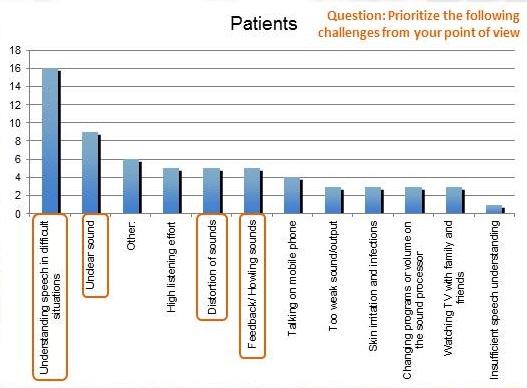
Figure 4. Patient survey of importance of listening issues.
These patient needs and requests ultimately resulted in the basis of our Ponto Plus family. It delivers the sound quality that you know from the previous Ponto sound processors with several improvements. First is a new transducer design; the second is Inium Feedback Shield, and the third is wireless capability.
New Features to the Ponto Plus
New Transducer
With the improvements in the transducer, we are improving sound quality by providing access to more everyday sounds for bone anchored hearing system users. I like talking about what we are trying to accomplish with the transducer. Consider this example. If we try to weigh an ant on a scale, its weight is so negligible that it would barely register, but if we put an elephant on the same scale, we could not get an accurate measurement due to the weight, and the scale would probably break. By comparison, the healthy ear easily handles sounds that are as soft as a whisper and loud as a jet plane all on the same scale. As you know, this example does not apply so cleanly to people who have hearing loss. The magnetic field in the new transducer has been maximized by our engineers. This means that while keeping the transducer the same size, we are able to greatly improve its efficiency, but we are not making any additional demands on the battery power of the device.
During development, we also fall/drop tested more than 100 of these transducers to ensure our reliability standards. The result of this engineering for your patients is a more powerful processor. Figure 5 shows an improvement in the mid to high frequencies for the Ponto Plus over the Ponto Pro. Furthermore, the Ponto Plus Power had an average increase of 3 to 4 dB across the same frequencies.
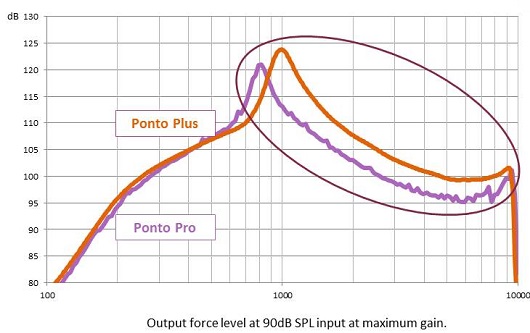
Figure 5. Output comparison of the Ponto Pro (purple) and Ponto Plus (orange); the Ponto Plus is equipped with a modified and improved transducer.
As mentioned, the improvement lies within design optimization. Although it is stronger, the geometry and power consumption of the transducer is still the same as the previous Ponto Pro family, but it has an improved efficiency. The graph in Figure 6 illustrates how the patient benefits from the stronger transducer. We made recordings in several different everyday user situations. The sound level (dB SPL), indicated by the shaded brown bars, varies greatly between the different situations. This variety in sound intensity per situation is what puts a demand on the sound processor. The orange plus symbols that you see in the middle of the bars indicates the average SPL for each measured situation. The first dotted line shows the intensity ceiling for a Ponto Pro, and beyond that, the sound becomes distorted. Users can cope with this in many situations, but not well in all situations. The second line shows the intensity ceiling for the Ponto Plus, which you can see is a stronger processor that will produce higher sound levels. We can also see how the increased power makes more of the sounds available to the user.
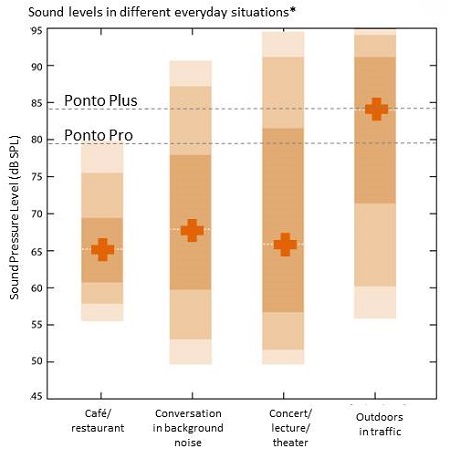
Figure 6. Variations of sound levels in everyday listening situations. The orange + indicates average intensity (dB SPL) for the given environment; the dashed lines indicate the intensity ceiling for each sound processor before sounds become distorted.
Inium Feedback Shield
The second improved feature is an important part of the Oticon Inium platform, and that is the Feedback Shield. Oticon Medical has always used a two-stage feedback management system, and it consists of a feedback manager and a dynamic feedback cancellation (DFC) system. The feedback manager takes into account individualized measurements that are conducted in the clinic using Genie Medical. The DFC system recognizes that situations are different, and it has been further optimized within the Inium platform.
To review, feedback limits are first measured in Genie Medical using the feedback manager tool, which tackles those static conditions and differences between patients. For example, we have highly individual feedback limits because of the positioning of an implant and processor from one patient to another. Completing this measurement is what provides a good working condition for optimizing the DFC settings.
The feedback path for each patient changes during their everyday life across situations - talking on the phone, wearing a helmet, during a hug, et cetera. There are many different situations in which something physically comes close to the sound processor. The DFC system is responsible for preventing feedback in these types of situations, and this is the more difficult part of feedback management. Feedback Shield has made a large improvement in this field. Ponto Plus has much less feedback and feedback-related artifacts than other bone anchored systems. As I mentioned before, this is a place where our synergies with Oticon shine through. This was a system developed for the high-end Oticon Alta.
The improvement of the DFC system lies within an improved decision-making strategy, as well as the possibility to separate feedback from pure tones before it occurs. If it occurs, Feedback Shield has more tools for taking care of feedback. We use phase inversion or phase cancellation as well as frequency shift, and we also are able to use a feedback limit estimation system, which means less artificial sound interfering with a user’s daily life.
Let’s go into the advanced signal processing components to the DFC system. We previously used phase inversion to subtract a copy of the signal that caused feedback, but despite these efforts, in some situations (e.g., pure tones), users still have trouble with the feedback sounds. A Facebook user was explaining how certain sounds are still triggering feedback in their Ponto Pro Power device. The user said that, “The only things which momentarily upset my Ponto Power are beeps of the microwave, crossings, and some music instruments with a similar pitch.” We now deal with this in a new way, by using frequency shift. We use it to break the path of feedback and make the device less sensitive to the types of offending tones described by that Facebook user. The mechanism of how this is happening is by providing a small frequency shift of 10 Hz to the input sound in order to disrupt the feedback signal. The feedback limit estimator is always running within DFC itself, which is just like a real-time feedback manager that is constantly updating the feedback limit, and it is adjusting the allowable gain in order to optimize each listening situation.
What does this all mean for you as a clinical audiologist? One new thing in the new Genie Medical software a way to adjust the DFC settings and decide if you would like to increase or decrease the actions of the system, based upon the patient's initial setting. I will get more into this in an upcoming presentation on Genie Medical. However, you need to know right now that the DFC setting is automatically prescribed based on the patient's hearing loss type and gain requirements when you start up Genie Medical.
Wireless Capability
The final new technological component of Ponto Plus sound processors that I want to talk about is the wireless capability. Some of you might be familiar with the Oticon Streamer and the ConnectLine system, so I do want to talk about how Ponto Streamer and the related components can provide even more benefit for bone anchored patients. The Ponto Streamer (Figure 7) offers the most connectivity options in one system, and it meets patients’ needs for a lot of different lifestyles. Uniquely, we only have one device to control the functionality of all of the following systems shown in Figure 7.
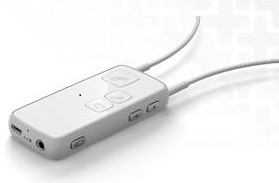

Figure 7. Ponto Streamer and its associated control functionalities.
Ponto Streamer
With the Ponto Streamer alone, patients can have access to five listening opportunities. The first is hands-free cell phone use. The second is a built-in Telecoil within the Streamer. The third is streaming music directly into the sound processor. Fourth is connecting the Ponto Streamer to computer audio, and fifth is using a simple remote for changing programs or adjusting volume on the Ponto Plus. The other five options (TV, land phone, microphone, FM and office phone) require an additional device alongside the Ponto Streamer.
Several of those required products are part of Oticon’s ConnectLine system. The TV adapter, the partner microphone or the ConnectLine microphone, and the phone adapter are all accessories with which you may be familiar if you have been using Oticon hearing instruments with the ConnectLine system. The FM solution using the Ponto Plus system requires a receiver with the Euro pin socket, which is then attached to the bottom of the Ponto Streamer.
ConnectLine accessories physically extend the communication possibilities for our patients, and if the streamer is paired to the TV adapter or to the landline phone adapter, the user can move up to 30 meters (100 feet) away from the sound source while the audio remains connected. With the ConnectLine microphone, the patient and the person who is wearing the microphone can be up to 15 meters (50 feet) apart. This is convenient for the TV adapter specifically, because everyone goes into the kitchen and get a snack or wanders away from the TV set for a minute. It is nice to still be able to stay connected, even if you have gone into a different room.
It is also a priority for us that our wireless communication system be simple for the patient. For example, when you initially receive the Streamer and pair it with the ConnectLine product that you are also using, it will remain connected. It only takes one time to do that. Also, it only takes one push on the Streamer itself to activate those different ConnectLine features, whether it is to answer the phone or connect to the TV. Input to the streamer is automatically prioritized in order of importance. For example, if you are watching TV and a phone call comes in on your cell phone, it is going to put the call through and pause the audio for the television in order for you to be able to take the call.
The FM system, as I outlined previously, is used through the Ponto Streamer with the Ponto Plus family. Oticon’s Amigo R2 is an example of a receiver that has a Euro pin socket that is compatible; any Euro pin socket receiver will properly connect to the Streamer. This provides a substantial benefit for bilateral fittings, because you only need to use one FM receiver, as opposed to two.
I wanted to address some common questions, and the first one is if Ponto Streamer needs to be worn around the neck in order for it to function. No, that is not the case; it can be worn in your pocket. However, for this to be an option, the Streamer needs to be directly linked to the sound processor within Genie Medical, much like how it is done with Oticon Streamer. This is a process that I will demonstrate in a couple of weeks at the Genie Medical lecture.
Since I just specified that it has to be linked, you might have questions. This idea of not linking a sound processor might be new. When a patient receives a Ponto Streamer, it is going to work correctly and connect to a user’s device right out of the box. We call that an open streamer, and this is different from how Oticon operates their Streamer. An open streamer sends a signal to any Ponto Plus device that is within a meter. It also means that, in this case, it does have to be used with the neckloop. If the patient wants to use the streamer without the neck loop, or if there is another case like having more than one Ponto Plus user in the same room, the Ponto Streamer and the Ponto Plus have to be linked. This is a quick two-step procedure that is done in Genie Medical.
Figure 8 shows a schematic of the Ponto Streamer and the functionalities of the buttons and ports. You will note that the button to connect to FM also is used for audio jack, the built-in Telecoil, and A2DP, which is a type of Bluetooth. It is the same kind of Bluetooth that is employed in a car system that allows you to connect your cell phone with your car. The other buttons are similar to the functionalities of the Oticon Streamer.
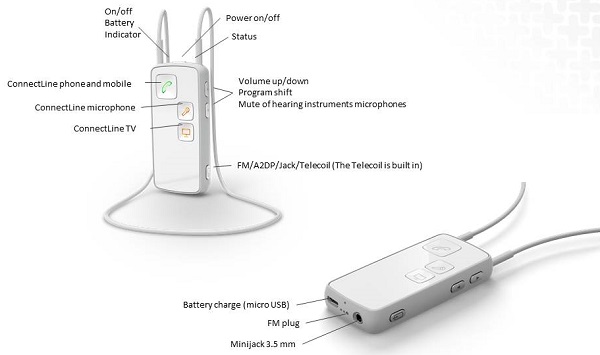
Figure 8. Ponto Streamer button and plug functionalities.
The Streamer battery is charged with a micro USB, and a fully charged streamer can last for up to 10 hours. Just as with our current sound processors, Ponto Plus has a design that is durable, reliable, and really easy to operate. It is been tested over and over so that we can confirm its ability to support the active lifestyles that our patients lead. With more than six years of having our sound processors out in the field, our features have been tested and stand for proven design and reliability as well. Of note, our sound processors do have an IP57 classification. This is a rating for resistance against moisture and dirt. It is the highest possible classification in its device class. It is still our recommendation to remove the sound processor when bathing or swimming as it is not waterproof, but it does have the highest possible water resistance classification.
Cosmetics
There are some exterior design changes to the Ponto Plus that I wanted to point out. First, based upon feedback from our markets, the hole for the safety line on the Ponto Plus has been moved. It is now at the bottom of the device; it was previously at the top. That was not working out so well for people who needed to wear the safety line. Additionally, the direct audio input (DAI) contact has been removed since the device is now wireless, and the design of the pushbutton has been updated.
If you look closely in Figure 9, you can see that it is covered in small pluses for Ponto Plus. Another new cosmetic addition is colorful skins and stickers (Figure 10), which will be applicable for both the existing sound processors as well as Ponto Plus. We have gotten positive feedback about this already. Our users are really loving it, especially in the pediatric markets. It gives them a great opportunity to personalize their sound processors. The stickers and a transparent skin are included in the box with all of the Ponto Plus sound processors. You can order a package that contains one of each different color if you choose.
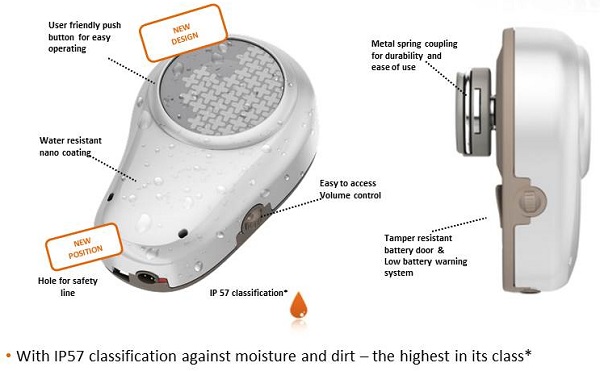
Figure 9. Ponto Plus up close.
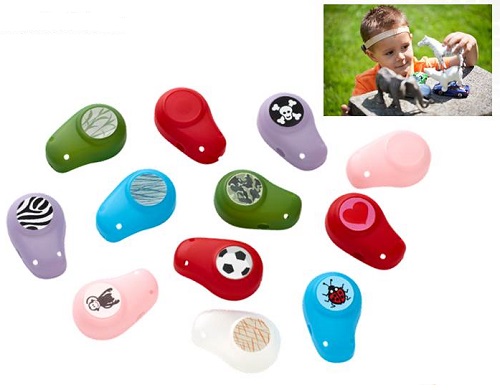
Figure 10. Colorful skins and stickers to personalize Ponto.
The Ponto Plus sound processor can provide users with a hearing solution that is going to address the known problems that they are facing. We are able to provide them with more everyday sounds through the new powerful transducer. We can provide them with less feedback and fewer artificial sounds by introducing the Inium Feedback Shield, and we have introduced new wireless communication possibilities through Ponto Streamer that extends communication in a variety of different situations. In addition, Ponto Plus still includes all of those existing well-known features of the current Ponto sound processor families. For us, the best solution is the one that provides the best lifelong patient outcomes. Ponto system is a complete solution that helps overcome challenges in all of the different treatment aspects. It is not only an audiological focus, but it includes a surgical system as well.
Tissue Preservation Surgical Technique
Let's discuss the tissue preservation surgical technique that is newly FDA-cleared and its relation to the Ponto systems implants and abutments. The wide Ponto implant has an OptiGrip geometry, which was designed to improve implant stability. It has the largest bone contact surface in the industry. The implant development has, in turn, enabled longer abutments to be used. Oticon Medical introduced a complete abutment family, including a 12 mm abutment in 2012, together with the wide implant. Figure 11 shows both the wide and standard implants, as well as the difference between the implant surface in contact with the bone. You can see how much more of that surface is in contact for the wide Ponto implant.
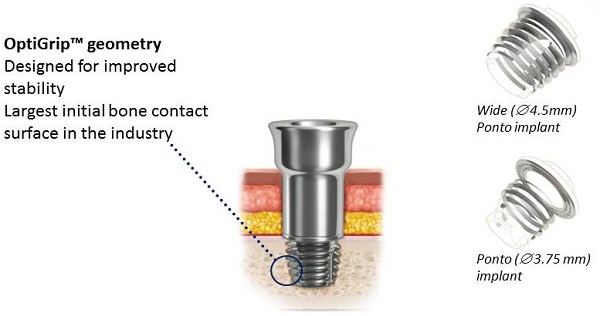
Figure 11. OptiGrip implant and comparison of wide and standard Ponto implants.
For the abutment, we use a design concept called OptiFit, which offers a geometry that is specifically designed to have minimal interference with the tissue. OptiFit offers several length abutments for different skin thicknesses, and it has a soft shoulder above the skin. Regardless of the abutment length, the skin meets an even surface all along the abutment interface from the periosteum to the outside of the skin, with no pockets for bacterial growth. All these components make the implant and the abutment system an ideal system to use in tissue preservation surgery.
Tissue preservation surgery follows the classical surgical procedure for bone anchored implants, except for the fact that no subcutaneous tissue is removed. This means the surgical site has minimal scar tissue in the end. Typically, you would use a linear incision with one of two different variations used by surgeons with this technique. We have seen in research that it is possibly advantageous to place the incision alongside the abutment, because in that case, the scar tissue development is minimized in the area right around the abutment, and there may be less risk of the abutment stressing the sutures during the healing process.
It is mostly important to choose the right abutment length for the surgical technique, and several methods exist to estimate what that length will be prior to the surgery. I have met with surgeons all around the world, and a lot of them have some interesting methods to do that, but those have been fairly clinic-specific procedures.
There are many benefits to doing a tissue preservation surgery. The one that we talk about most is the cosmetic outcome. I have included some of those examples in Figure 12. The pictures on the left show the abutment without the sound processor, and then on the right the sound processor is attached.
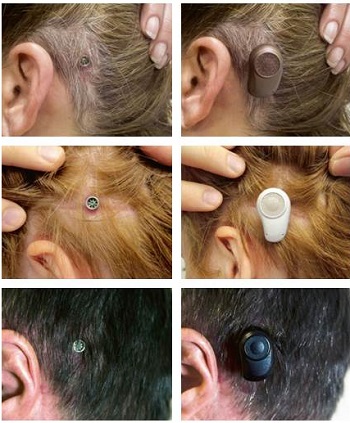
Figure 12. Examples of tissue preservation outcomes after surgery and processor loading.
As I said before, the linear incision with tissue preservation technique has less scar tissue. There is also no groove in the skin, which can be characteristic of different types of surgical procedures. There is also no hairless spot on the scalp, which can be a major patient concern. Additional benefits for this procedure include less numbness in the incision area as compared to the dermatome method, because there is less chance of interfering with the nerves in the area. Additionally there is a quicker healing time because the surgery is less invasive. Less time is spent performing the surgery, which is a benefit in terms of the operating room cost. That can be a great benefit.
I would also like to add that the FDA has provided Oticon Medical clearance to talk about tissue preservation and describe tissue preservation in our surgery manuals now. I think it is important to know that we received FDA clearance to change our labeling specifically about tissue preservation.
Summary
You should always be thinking about lifelong patient outcomes when you are considering a bone anchored hearing system. From the inside out, the Ponto system offers the OptiGrip implant for improved stability, OptiFit abutment concept for minimal tissue interference, the Ponto sound processors - in this case the newest Ponto Plus family for top sound quality - and then the Ponto Streamer to open up the world of wireless communication.
Questions and Answers
Does the Streamer have bimodal capabilities?
This would obviously be assuming that the individual is using an Oticon hearing aid on the opposite side. The Oticon hearing aid works with the ConnectLine system, which is the same one as what the Ponto Streamer and the Ponto Plus use. If we are using the connectivity options such as television, phone, microphone, FM, and office phone solutions, then we are using a ConnectLine product. Both the Oticon hearing aid and the Ponto streamer are designed so that they interface with the same product. In this case, you would pick which input you wanted to use. When you connect the Ponto streamer to use the TV box, for example, only one streamer can be connected to the ConnectLine box itself. You would have to make a selection of which one the patient would rather use for their auditory input.
Can you please explain frequency shift in relation to feedback management?
What is happening with frequency shift is that the input signal coming into the processor, for example, a microwave beep, is causing some feedback in the processor. The processor is changing that input signal to break the feedback path. It switches the input signal very slightly, just by 10 Hz. It is a dynamic frequency shift in order to stop the feedback from happening,
Can you talk a little bit more about Ponto Streamer?
We chose to have the Ponto Streamer work out-of-the-box in a way that is different from how Oticon works with their streamers. It is a great idea to be able to order a streamer and not have to have an appointment with an audiologist to program. We know that the Streamer is going to work in that case with the individual’s device. They would be able to directly order the Streamer, put it on, and be ready to go.
Can you also talk about when to use ConnectLine versus when to use Streamer?
These are the specific situations in which you are using ConnectLine product in addition to using Ponto Streamer: the ConnectLine TV adapter, the ConnectLine microphone, the ConnectLine landline phone adapter, and the office phone.
How does one use the Telecoil feature with the landline phone? Does the patient have to have a separate program for this?
In this case, the Telecoil is built directly into the streamer itself. Wearing the neckloop is close enough proximity for them to use the landline phone in this way. You are correct that it could be used in this way if you had a landline phone that had a strong Telecoil connection.
What is the battery life of the Streamer?
It is 10 hours, and that can be divided up into six hours of streaming consistently, like on the phone, and then four hours of standby use.
If the Ponto Streamer is linked, can it be used without a neckloop?
Yes.
Do you recommend using ConnectLine with children?
Yes, very much. It has been my experience that Europe is a little bit different than the U.S. I have seen and heard of children in kindergarten age classes that are able to quickly learn the functionalities of the Streamer. It is the same kind of situation as when children are handed an iPhone. I am amazed that they know what to do, but it is pretty intuitive for them. I have also met with some children who have motor coordination issues. For them, pressing the button to switch programs for their FM system, for example, was difficult, and they needed assistance for that. If they wear the Ponto Streamer in the classroom and the ConnectLine at home, it gives them some increased independence.
Can you confirm that streaming does not impact the sound processor’s battery life?
I would need to get a technical specification to be completely accurate on that.
Cite this content as:
Westbrook, J. (2014, May). Introducing Ponto Plus. AudiologyOnline, Article 12678. Retrieved from: https://www.audiologyonline.com


